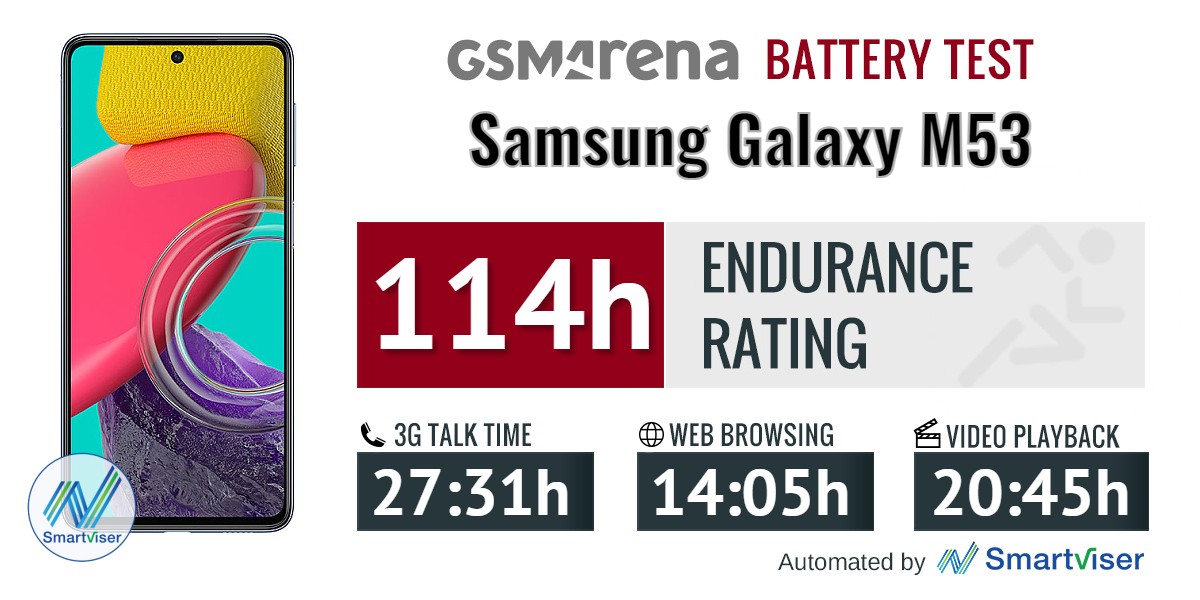Introduction
Samsung's midrange M-series was upgraded earlier this year, and we got our hands on the Galaxy M53 after covering its A-series counterpart a couple of months ago. We did say 'upgrade' in the previous sentence, but is it really? Let's go over the specs to see where it stands on paper.

For starters, the cameras are a 'neither here, nor there' type of situation - the main one has gotten a larger and higher-res sensor but that's at the expense of the ultrawide and the macro units which have both been downgraded.
Then there's the chipset - nothing's wrong with the 5G-capable Dimensity 900 we have here, but the Snapdragon 778 of the predecessor is a more potent performer.
The 6.7-inch OLED display with a 120Hz maximum refresh rate is still here; no complaints. The battery capacity, while far from the M51's class-leading 7,000mAh, remains at 5,000mAh as was on the M52, so this too can be filed under 'no change is a good thing'. The 25W charging rating remains too.
Samsung Galaxy M53 specs at a glance:
- Body: 164.7x77.0x7.4mm, 176g; plastic back, plastic frame.
- Display: 6.70" Super AMOLED Plus, 120Hz, 1080x2408px resolution, 20.07:9 aspect ratio, 394ppi.
- Chipset: MediaTek MT6877 Dimensity 900 (6 nm): Octa-core (2x2.4 GHz Cortex-A78 & 6x2.0 GHz Cortex-A55); Mali-G68 MC4.
- Memory: 128GB 6GB RAM, 128GB 8GB RAM, 256GB 8GB RAM; microSDXC (uses shared SIM slot).
- OS/Software: Android 12, One UI 4.1.
- Rear camera: Wide (main): 108 MP, f/1.8, PDAF; Ultra wide angle: 8 MP, f/2.2, 1/4", 1.12µm; Macro: 2 MP, f/2.4; Depth: 2 MP, f/2.4.
- Front camera: 32 MP, f/2.2, 26mm (wide).
- Video capture: Rear camera: 4K@30fps, 1080p@30/60fps; Front camera: 4K@30fps, 1080p@30fps.
- Battery: 5000mAh; Fast charging 25W.
- Misc: Fingerprint reader (side-mounted).
Samsung Galaxy M53 unboxing
Another downgrade, and a very tangible one at that, is in the box and its contents. The two-piece white cardboard box is now half-height, which immediately tells you there's no charger inside. There still is a USB-C cable - maybe for the last time, the way things are going.

Design
Samsung's design language in the midrange has been a little inconsistent, though it's somewhat understandable with a lineup as wide as that. The A-series appear to have settled on a universal styling which this year was extended all the way down to the A13, though the lesser models do still maintain some different traits.
Which brings us to the Galaxy M53 we have here that isn't showing a whole lot of continuity coming from last year's M52 5G, though it's still clearly different from the As.

The quad-camera arrangement is the most distinct bit about the M53's appearance and it's been seen in lower-end A-series models last year, the occasional F model and whatnot. This time around, however, Samsung has opted for a seamless mold of the bulge as part of the rear panel - so while not exactly novel, it's not entirely the same as previous ones either. We have to say we're liking it.

As best as we can tell, the panel is made of plastic and is treated to a frosted finish that can play around with light and morph into various hues of blue (in the case of our review unit's Blue colorway, that is). Mind you, the official photos don't remotely do the color any justice - that navy only shows up if you angle the handset down so that no light is reflected towards you. We reckon it's a similar story with the Green and Brown options.
Going from looks to practicality, we actually appreciate the switch from the M52 5G's glossy rear to this sort of matte surface. Hardly fingerprint-proof - in fact it does pick up its share of smudges, it still tends to look a lot cleaner in and after use than last year's model.

The frame of the Galaxy M53 is glossy, though, so it will be more prone to getting smudged up, but then it's thin enough and curved so that you're not looking a large flat greasy mirror surface. The frame is made of plastic too.

Slightly recessed into that frame, you'll find the power button with a fingerprint sensor embedded in it - on the right side of the phone, a bit above the midpoint. That places is in a fairly convenient spot for operation with the right thumb of an average male hand. Accessing it with a left index finger may be equally easy or somewhat more of a deliberate exercise, depending on how you grip your phone, though habit should quickly replace whatever initial awkwardness there may be.

Since it's also a button, there's a provision in settings to make the phone require a click in order to interpret pressing it as an unlock attempt. That way you can minimize the likelihood of accidental scans. Both the power button and the volume rocker above it click reassuringly.
On the opposite side is where the card slot lives. It's a dual slot that will either take two nano SIM cards, or a nano SIM and a microSD, but not all three at the same time. The tray also features a seal to keep the slot clean, but the phone has no formal IP rating - the A-series will get you that.


Buttons on the right • Hybrid card slot on the left
The M51 was the last one to have a headphone jack and the M53, like the M52 before it, omits this legacy form of connectivity. The USB-C port is on the bottom and will take a headphone dongle if you so insist and can find one.
Also on the bottom is the only loudspeaker of the Galaxy M53 - there's no stereo action on this handset. Well, there is, but for input only - there's a mic at each end of the phone.


USB-C port on the bottom • Lone mic pinhole up top
The Gorilla Glass 5 covered display is mostly unremarkable from a design perspective. It's got just the right amount of bezel you'd expect from a phone in this class, though admittedly that does mean less bezel than a couple of years ago.

A punch hole at the top end of the panel allows light to make its way to the selfie camera. That too is an average-sized punchhole, so to speak - not large enough to be an eyesore, but not tiny either since it has to accommodate a relatively large sensor.
The earpiece-only slit is chiseled from the glass - so thin you can barely see it.

The Galaxy M53 measures 164.7x77x7.4mm and weighs 176g so it's essentially the same size and weight as the previous model. The shock value of the M52 shaving 40g of weight and 2mm of thickness compared to the M51 chonker is gone, but we can still appreciate the current phone's sensible heft and quite impressive thinness. It's still a 6.7-inch smartphone, so it's anything but compact, but we'll settle for manageable.

6.7-inch 120Hz AMOLED with 120Hz refresh rate
The Galaxy M53 maintains a slight edge over the A53 when it comes to display size - it stands at 6.7 inches in diagonal, compared to the 6.5 inches of the higher-end model - same as last year then. The panel is branded Super AMOLED Plus and has a 1080x2400px resolution and a 120Hz maximum refresh rate.

We measured just over 800nits of maximum brightness in bright ambient conditions with the adaptive brightness enabled and 403nits when operating the slider manually. These are pretty great numbers for a handset in this class, though the A53's 30-ish extra nits do award it the bragging rights.
| Display test | 100% brightness | ||
| Black, |
White, |
||
| 0 | 403 | ∞ | |
| 0 | 802 | ∞ | |
| 0 | 402 | ∞ | |
| 0 | 777 | ∞ | |
| 0 | 427 | ∞ | |
| 0 | 830 | ∞ | |
| 0 | 378 | ∞ | |
| 0 | 787 | ∞ | |
| 0 | 383 | ∞ | |
| 0 | 800 | ∞ | |
| 0 | 407 | ∞ | |
| 0 | 728 | ∞ | |
| 0 | 433 | ∞ | |
| 0 | 613 | ∞ | |
| 0 | 530 | ∞ | |
| 0 | 1003 | ∞ | |
| 0 | 481 | ∞ | |
| 0 | 863 | ∞ | |
| 0 | 487 | ∞ | |
| 0 | 772 | ∞ | |
| 0 | 461 | ∞ | |
| 0 | 647 | ∞ | |
| 0 | 514 | ∞ | |
| 0 | 846 | ∞ | |
| 0 | 456 | ∞ | |
| 0 | 635 | ∞ | |
| 0 | 683 | ∞ | |
Color handling is implemented in the usual Samsung way. There are two modes - Vivid and Natural, the first one being the default. In Vivid mode you get a five-position temperature slider as well as RGB sliders behind an 'Advanced settings' button. This Vivid mode supports a wide color gamut and is fairly accurate for displaying DCI-P3 content, though we did measure slightly higher deviations from the targets than we did on the older model. The all too typical faint blue tint can be overcome by nudging the temp slider in the warm direction.
Natural mode was similarly not quite as accurate for displaying sRGB content as was the M52, but was still closer to the targets for our test swatches than Vivid was for DCI-P3.
Samsung makes no claims for HDR capability on the Galaxy M53 and HDR checker apps list no HDR support whatsoever - the M52 would at least play HDR in YouTube, but not the M53. The Widevine L1 certification does mean you can get FullHD resolution in Netflix and Amazon Prime Video.
You get the usual Motion smoothness menu item in display settings for enabling the 120Hz refresh rate. The Standard options delivers 60Hz across the board, as expected.

The High setting, conversely, pretty much locks things at 120Hz - there's no adaptive activity-based switching of any sort. That means that even for video playback you'd be getting the full 120Hz (in the Gallery, YouTube, Netflix, Google Photos - everywhere, basically), which is hardly ideal in terms of battery life. The actual renderer will render things at different fps depending on content, but the screen will refresh at 120Hz anyway. The usual exceptions apply as well - the camera viewfinder and Google Maps do force a switch to 60Hz.
What's most admirable is that the M53 does allow for high frame rate gaming and will keep the display at 120Hz for games that can go beyond 60fps, only leaving it up to GPU's performance to limit the frame count.
Samsung Galaxy M53 battery life
The Galaxy M53 has a 5,000mAh battery inside - same as on the M52, but a far cry from the 7,000mAh of the M51. With the A53 now at 5,000mAh too (the A52 bunch had 4,500mAh power packs), the M model has lost this nominal advantage as well.
It still maintains an edge in some areas though. In our testing, the M53 was good for 14 hours of Wi-Fi web browsing (at a constant 120Hz) which is more than an hour on top of the A53's result. The 20:45h of looping videos offline (at 60Hz) is slightly better than the A53's number too. The M53 wasn't quite as good at voice call longevity, but the 27:31h result isn't half bad either.
The overall Endurance rating of the Galaxy M53 adds up to 114h - not as good as the M52, but respectable nonetheless. Obviously, the 156h result of the M51 is no longer possible.

Our battery tests were automated thanks to SmartViser, using its viSerDevice app. The endurance rating denotes how long the battery charge will last you if you use the device for an hour of telephony, web browsing, and video playback daily. More details can be found here.
Video test carried out in 60Hz refresh rate mode. Web browsing test done at the display's highest refresh rate whenever possible. Refer to the respective reviews for specifics. To adjust the endurance rating formula to match your own usage - check out our all-time battery test results chart.
Charging speed
There's no charger inside the Galaxy M53's box, a reality we'll have to learn to live with. We do have a standard 25W Samsung adapter which is what the M53 is rated for so we tested the phone's charging speed with that one.

We measured 1:33h for a full charge from flat and the battery indicator was showing 44% at the half-hour mark. Charging power peaked at a little over 20W. That's what you can reasonably expect to get with pretty much any recent adapter that adheres to the USB Power Delivery standard. If you have one of the older 15W Samsung adapters lying around, you'd be looking at longer charging times, though we didn't have one for testing.
The M53 is more or less as quick to charge as the A53, with the A33 somewhat quicker. The A52 5G from last year was marginally quicker than this year's model too, when using the same 25W adapter, but then again it came bundled with a 15W one, which was slower - which one is the 'correct' comparison?
30min charging test (from 0%)
Higher is better
- Oppo Reno7 5G
90% - Honor Magic4 Lite
77% - OnePlus Nord CE 5G
67% - Xiaomi Mi 11 Lite 5G
58% - OnePlus Nord N20 5G
57% - Samsung Galaxy A52s 5G
53% - Oppo Reno7 Lite 5G
52% - Xiaomi Redmi Note 11S 5G
51% - Samsung Galaxy M52 5G (25W)
50% - Samsung Galaxy A33 5G
50% - Samsung Galaxy A53 5G
45% - Samsung Galaxy M53
44% - Samsung Galaxy A52 5G
34% - Samsung Galaxy M52 5G (15W)
30% - Sony Xperia 10 IV (65W PD)
26%
Time to full charge (from 0%)
Lower is better
- Oppo Reno7 5G
0:37h - Honor Magic4 Lite
0:59h - OnePlus Nord CE 5G
1:03h - Xiaomi Mi 11 Lite 5G
1:04h - OnePlus Nord N20 5G
1:08h - Oppo Reno7 Lite 5G
1:11h - Samsung Galaxy A33 5G
1:15h - Xiaomi Redmi Note 11S 5G
1:17h - Samsung Galaxy M52 5G (25W)
1:19h - Samsung Galaxy A53 5G
1:24h - Samsung Galaxy A52s 5G
1:28h - Samsung Galaxy M53
1:33h - Samsung Galaxy A52 5G
1:39h - Samsung Galaxy M52 5G (15W)
1:48h - Sony Xperia 10 IV (65W PD)
2:35h
Speaker test
As before, the Galaxy M53 has a single loudspeaker. Similarly to the M52, the latest model isn't overly loud either, only making it into the Average tier when it comes to volume. The Galaxy A53 is louder and has a pair of speakers so it's a clear step up in this department.
 Single bottom-firing speaker on the Galaxy M53
Single bottom-firing speaker on the Galaxy M53
Sound quality is pretty decent though, a notch better than on the M52 and without glaring faults throughout the frequency range.
Use the Playback controls to listen to the phone sample recordings (best use headphones). We measure the average loudness of the speakers in LUFS. A lower absolute value means a louder sound. A look at the frequency response chart will tell you how far off the ideal "0db" flat line is the reproduction of the bass, treble, and mid frequencies. You can add more phones to compare how they differ. The scores and ratings are not comparable with our older loudspeaker test. Learn more about how we test here.
The Galaxy M53 runs the latest Android 12 with One UI 4.1 - a combo we've seen on the A53 and A33, as well as retrofitted on the flagship S22 series. It is still missing the occasional feature here and there compared to the S models, but nothing unexpected or too major for most users.

An always-on display is available and you can choose between a few clock styles or opt for an Image Clock. Music info is also supported. The feature can be always-off, always-on, scheduled, shown only when new notifications are available, or you can opt for tap-to-show for 10s.
The lock screen looks the same as before with two monochrome shortcuts - dialer and camera. A bunch of customization options are available.
The fingerprint reader on the right side of the frame will likely be the primary method of unlocking for most, but you can still use face unlock - either instead of or alongside it. It can be more convenient in certain situations, but it generally is less secure since it's just using the selfie camera.
One UI 4.1 looks even cleaner than v.3.x, but its logic remains the same - there are homescreens with app shortcuts and widgets, an app drawer, a notification center with quick toggles, and a task switcher.
Among the One UI 4.1 features missing on the M53 are Samsung's new Smart Widgets. We've only seen them on the high-models though - neither the A53, nor the A33 have them, so maybe they are limited to more expensive Galaxies. They are really convenient since they allow joining data from a few widgets into a single one - not on the M53 though.






Homescreen • Folder view • App drawer • Notifications • Task switcher • No smart widgets
One of the new One UI 4 features is Color Palettes. This is the implementation of the vanilla Android 12's Wallpaper colors. There are usually four Color Palette suggestions in addition to the default One UI Blue/Black one. Those are picked automatically by the software, depending on your current wallpaper. The color you choose will become the main one in the newly created theme (think Windows' "accent color").
These accent colors are applied on the dialer, the quick toggles, and other tiny UI bits. You can choose to apply them to the app icons as well, though non-Samsung apps won't comply and you can get an inconsistent look.
One UI has always offered great customization. You can use one of a few wallpaper services to automatically change your lockscreen or homescreen. The powerful Theme engine is here as well.





Wallpaper services • Galaxy Themes
The dialer allows you to pick between two layouts for the in-call screen. You can also set up a background image or video for that screen, though it's going to be all the same for all of your calls - you can't have a different one on a per-person basis.
Navigation is highly-customizable. You can go with gestures and tweak them to your liking or revert back to old-school buttons and even swap the home and back buttons for a truly retro navigation scheme.






Dialer customization • Dialer customization • Dialer customization • Navigation
The Settings menu contains a new Privacy Dashboard. Here, you can easily see which apps use some of the most important permissions (for privacy). You can control the camera and control access across apps, opt for clipboard access alerts (useful if you copy passwords, social security numbers, IBANs, among others), and a full-blown permission manager if you like to dig deeper.
You get a whole bunch of options for using your Galaxy with other devices to enable various use cases. Wireless display is the most obvious one. You can just do display mirroring this way though since the Galaxy M53 lacks Samsung DeX. It is still reserved for Samsung's flagship devices and hasn't made its way down the chain.
The Link to Windows feature provides you with an interface to your phone from your computer so you can exchange images, manage notifications on your PC or even make calls from it.
Another option along those lines but with more limited potential is Continue apps on other devices. This requires you to be logged in to your Samsung account on both devices, hook them up to the same Wi-Fi network with Bluetooth enabled and use the Samsung Internet browser or Samsung Notes. You'll then be able to copy and paste text and images across and open the same tabs in the browser.




No DeX • Continue apps on other devices • Link to Windows • Android Auto
Other staples of proprietary Samsung software include the Edge panels - the panes that show up when you swipe in from the side and provide tools and shortcuts to apps and contacts. Game launcher, the hub for all your games, which also provides options for limiting distraction when gaming, is here to stay as well.
Otherwise, the software package is similar to other Samsung phones, with an in-house Gallery app and a proprietary file manager. Naturally, Samsung's Internet web browser is also available.





Gallery • File manager • Edge panels
Beyond all of this, the Galaxy M53 comes loaded with a standard set of apps from Samsung, Microsoft and Google - some of these you can choose not install in the first place, at the initial setup stage. Granted, the list has gotten a bit extensive, but there is nothing here that we would consider bloat in the traditional sense. Anything that's slipped through during setup that you don't personally like or appreciate having on your device can be easily uninstalled or, failing that - disabled.
Synthetic benchmarks
The Galaxy M53 is equipped with the Dimensity 900 - a 5G capable chipset from Mediatek. Manufactured on a 6nm process, it features an octa-core CPU in a 2+6 configuration (2x2.4 GHz Cortex-A78 & 6x2.0 GHz Cortex-A55). That's a downgrade compared to the 4 A78s in the Snapdragon 778 of the Galaxy M52 5G, which will quickly show in GeekBench. Similarly, the Mali-G68 MC4 GPU will prove to be a step down from the Adreno 642L of last year's model.

At least three RAM and storage versions exist, starting from our review unit's 6GB/128GB spec, through 8GB/128GB, and peaking at 8GB/256GB. You may not get all versions in all markets, as usual.
In the single-core test in GeekBench, the Galaxy M53 does outscore the M52 5G, and is roughly on par with the A53 and A52s. In the multi-core test, however, the M53 drops behind both of last year's models, though it manages to pull ahead of the A53. 2022 is a weird year for midrange SoCs, no two ways about it.
GeekBench 5 (single-core)
Higher is better
- iQOO 9 SE
1095 - iQOO Neo 6
984 - Realme 9 Pro+
814 - Xiaomi 11 Lite 5G NE
787 - Samsung Galaxy A52s 5G
771 - Samsung Galaxy A53 5G
743 - Samsung Galaxy A33 5G
742 - Oppo Reno7 5G
738 - Xiaomi Redmi Note 11 Pro+ 5G
736 - Samsung Galaxy M53
730 - OnePlus Nord CE 2 5G
728 - OnePlus Nord CE 2 Lite 5G
694 - OnePlus Nord N20 5G
676 - Honor Magic4 Lite
666 - Sony Xperia 10 IV
662 - Samsung Galaxy M52 5G
603
GeekBench 5 (multi-core)
Higher is better
- iQOO 9 SE
3442 - iQOO Neo 6
3076 - Xiaomi 11 Lite 5G NE
2832 - Samsung Galaxy A52s 5G
2801 - Samsung Galaxy M52 5G
2796 - Realme 9 Pro+
2335 - Oppo Reno7 5G
2276 - Xiaomi Redmi Note 11 Pro+ 5G
2225 - OnePlus Nord CE 2 5G
2157 - Samsung Galaxy M53
2037 - OnePlus Nord CE 2 Lite 5G
1956 - OnePlus Nord N20 5G
1945 - Sony Xperia 10 IV
1908 - Honor Magic4 Lite
1906 - Samsung Galaxy A33 5G
1900 - Samsung Galaxy A53 5G
1891
The M53 is also the highest-scoring midrange Galaxy we've seen this year (A73 should top it, but we haven't been graced with its presence) - the A53 and the A33 don't quite cut it. Then again, the A52s and the M52 from 2021 are way higher up the chart.
AnTuTu 9
Higher is better
- iQOO 9 SE
846231 - iQOO Neo 6
730223 - Xiaomi 11 Lite 5G NE
527663 - Samsung Galaxy A52s 5G
506432 - Samsung Galaxy M52 5G
504424 - Oppo Reno7 5G
479608 - Xiaomi Redmi Note 11 Pro+ 5G
437872 - OnePlus Nord CE 2 5G
436640 - Samsung Galaxy M53
436197 - Realme 9 Pro+
416031 - OnePlus Nord CE 2 Lite 5G
399306 - Sony Xperia 10 IV
396008 - Samsung Galaxy A33 5G
394918 - Honor Magic4 Lite
387218 - OnePlus Nord N20 5G
380672 - Samsung Galaxy A53 5G
379313
The M53's GPU is roughly on par with the ones that the A53 and A33 get - perhaps that's some consolation, but we're still kind of sour about the downgrade from the 52 generation.
GFX Aztek ES 3.1 High (onscreen)
Higher is better
- iQOO 9 SE
42 - iQOO Neo 6
32 - Samsung Galaxy A52s 5G
19 - Xiaomi 11 Lite 5G NE
19 - Samsung Galaxy M52 5G
18 - Realme 9 Pro+
17 - Samsung Galaxy M53
16 - OnePlus Nord CE 2 5G
15 - Samsung Galaxy A53 5G
15 - Samsung Galaxy A33 5G
15 - OnePlus Nord CE 2 Lite 5G
12 - OnePlus Nord N20 5G
12 - Sony Xperia 10 IV
11 - Honor Magic4 Lite
11
GFX Aztek ES 3.1 High (offscreen 1440p)
Higher is better
- iQOO 9 SE
29 - iQOO Neo 6
22 - Samsung Galaxy M52 5G
13 - Samsung Galaxy A52s 5G
13 - Xiaomi 11 Lite 5G NE
13 - Realme 9 Pro+
11 - Samsung Galaxy M53
10 - OnePlus Nord CE 2 5G
10 - Samsung Galaxy A53 5G
10 - Samsung Galaxy A33 5G
10 - OnePlus Nord CE 2 Lite 5G
7.9 - OnePlus Nord N20 5G
7.8 - Sony Xperia 10 IV
7.8 - Honor Magic4 Lite
7.8
GFX Aztek Vulkan High (onscreen)
Higher is better
- iQOO 9 SE
43 - iQOO Neo 6
34 - Samsung Galaxy A52s 5G
20 - Xiaomi 11 Lite 5G NE
20 - Samsung Galaxy M52 5G
19 - Realme 9 Pro+
16 - Samsung Galaxy M53
15 - Samsung Galaxy A53 5G
15 - Samsung Galaxy A33 5G
15 - OnePlus Nord CE 2 5G
14 - OnePlus Nord CE 2 Lite 5G
12 - OnePlus Nord N20 5G
12 - Honor Magic4 Lite
12 - Sony Xperia 10 IV
11
GFX Aztek Vulkan High (offscreen 1440p)
Higher is better
- iQOO 9 SE
30 - iQOO Neo 6
24 - Samsung Galaxy M52 5G
14 - Samsung Galaxy A52s 5G
14 - Xiaomi 11 Lite 5G NE
14 - Realme 9 Pro+
10 - Samsung Galaxy A53 5G
10 - Samsung Galaxy A33 5G
10 - Samsung Galaxy M53
9.8 - OnePlus Nord CE 2 5G
9.4 - OnePlus Nord CE 2 Lite 5G
8.2 - OnePlus Nord N20 5G
8.2 - Sony Xperia 10 IV
8.2 - Honor Magic4 Lite
8.1
GFX Car Chase ES 3.1 (onscreen)
Higher is better
- iQOO 9 SE
64 - iQOO Neo 6
50 - Samsung Galaxy M52 5G
28 - Samsung Galaxy A52s 5G
28 - Xiaomi 11 Lite 5G NE
28 - Realme 9 Pro+
23 - Xiaomi Redmi Note 11 Pro+ 5G
22 - Samsung Galaxy M53
21 - Oppo Reno7 5G
20 - Samsung Galaxy A33 5G
20 - OnePlus Nord CE 2 5G
19 - Samsung Galaxy A53 5G
19 - OnePlus Nord CE 2 Lite 5G
17 - Honor Magic4 Lite
17 - OnePlus Nord N20 5G
16 - Sony Xperia 10 IV
16
GFX Car Chase ES 3.1 (offscreen 1080p)
Higher is better
- iQOO 9 SE
73 - iQOO Neo 6
58 - Samsung Galaxy M52 5G
33 - Samsung Galaxy A52s 5G
33 - Xiaomi 11 Lite 5G NE
33 - Realme 9 Pro+
27 - Samsung Galaxy M53
26 - Xiaomi Redmi Note 11 Pro+ 5G
25 - Oppo Reno7 5G
24 - OnePlus Nord CE 2 5G
24 - Samsung Galaxy A53 5G
23 - Samsung Galaxy A33 5G
23 - Honor Magic4 Lite
21 - OnePlus Nord CE 2 Lite 5G
20 - OnePlus Nord N20 5G
20 - Sony Xperia 10 IV
20
GFX Manhattan ES 3.1 (onscreen)
Higher is better
- iQOO 9 SE
103 - iQOO Neo 6
84 - Samsung Galaxy A52s 5G
49 - Xiaomi 11 Lite 5G NE
49 - Samsung Galaxy M52 5G
47 - Realme 9 Pro+
41 - Samsung Galaxy M53
38 - Xiaomi Redmi Note 11 Pro+ 5G
38 - Oppo Reno7 5G
36 - OnePlus Nord CE 2 5G
35 - Samsung Galaxy A53 5G
35 - Samsung Galaxy A33 5G
35 - OnePlus Nord CE 2 Lite 5G
30 - OnePlus Nord N20 5G
29 - Honor Magic4 Lite
29 - Sony Xperia 10 IV
28
GFX Manhattan ES 3.1 (offscreen 1080p)
Higher is better
- iQOO 9 SE
117 - iQOO Neo 6
95 - Samsung Galaxy M52 5G
56 - Samsung Galaxy A52s 5G
56 - Xiaomi 11 Lite 5G NE
56 - Realme 9 Pro+
45 - Xiaomi Redmi Note 11 Pro+ 5G
43 - Samsung Galaxy M53
42 - Oppo Reno7 5G
42 - OnePlus Nord CE 2 5G
40 - Samsung Galaxy A53 5G
38 - Samsung Galaxy A33 5G
38 - OnePlus Nord CE 2 Lite 5G
35 - OnePlus Nord N20 5G
35 - Sony Xperia 10 IV
35 - Honor Magic4 Lite
35
3DMark Wild Life Vulkan 1.1 (offscreen 1440p)
Higher is better
- iQOO 9 SE
5463 - iQOO Neo 6
4225 - Samsung Galaxy A52s 5G
2491 - Xiaomi 11 Lite 5G NE
2477 - Samsung Galaxy M52 5G
2470 - Realme 9 Pro+
2296 - Samsung Galaxy A53 5G
2292 - Samsung Galaxy A33 5G
2260 - Samsung Galaxy M53
2203 - Oppo Reno7 5G
2037 - OnePlus Nord CE 2 5G
2036 - Xiaomi Redmi Note 11 Pro+ 5G
2014 - Sony Xperia 10 IV
1213 - Honor Magic4 Lite
1211 - OnePlus Nord CE 2 Lite 5G
1209 - OnePlus Nord N20 5G
1205
Sustained CPU load revealed an oddly choppy behavior from the Galaxy M53 - other implementations of the Dimensity 900 have been a lot more stable. On a positive note, the result in the 3DMark Wild Life test was rock solid.


CPU throttling test • 3DMark Wild Life stress test
In summary, the Galaxy M53 is a decently capable performer. Its GPU is about as potent as the ones on other mid-tier Galaxies, while the CPU numbers were a bit more inconsistent. In any case, however, the chipset is a downgrade from last year's model.
Two real cameras on the back, 32MP selfies
The Galaxy M53 comes with a reworked camera system compared to the previous model. In principle, you get two real cameras - a big-sensor main one and a more modest ultrawide, plus a couple of sidekicks. In a way, that makes it closer to the M51's 2+2 arrangement than the M52 5G's 2+1, but what comes after the plus is rarely exciting to begin with.

The primary camera is built around the Samsung Isocell HM6 sensor. This 1/1.67" imager is one of the latest designs with the tiniest of pixels - 0.64µm, but it does have a whole 108 million of them. A Nonapixel color filter array means you get nine-to-one binning and 12MP resulting images by default. The lens has an f/1.8 aperture and the EXIF data reports a wide 23mm equivalent focal length.
The ultrawide is, predictably, even wider - 13mm the files say. It's gotten a resolution downgrade and the number is 8MP now, down from 12MP on the M52 5G. The Sony IMX 355 sensor is a popular one - it's used on the Galaxy A33, as well as the Realme 9 Pro+ and the Reno7 5G, to name a few. Similarly to all those implementations, the ultrawide camera on the M53 doesn't have autofocus.
Which brings us to the pair of 2MP auxiliary cameras. One is labeled 'macro', the other is a depth sensor. As you can see, the macro isn't the half-decent 5MP unit Samsung used on last-year's M52 5G and on models higher up the lineup, but an even more basic one.
There are no changes on the front - the M53 uses the 32MP selfie camera (Sony IMX 616) found on the M52 5G and the M51, as well as the A52s and A53 (and possibly countless other models). It outputs 12MP images by default - Samsung's usual if slightly illogical numbers manipulation for its 32MP selfie cams.

The camera app is the same one you'd find on every Samsung phone these days. Swiping left and right will switch between all available modes, and there's an option to re-arrange or remove some of the modes from the viewfinder. Vertical swipes in either direction will switch between front and rear cameras.
The settings icon is located in the upper left corner of the screen and you don't get separate setting screens for photos and videos since the options aren't that many in total. Grid lines, location data, Screen optimizer, etc. - the usual stuff can be found there. The full resolution mode on the primary camera is triggered from the aspect options, which is a rather unintuitive bit, but that's how Samsung does it.
There's a Pro mode, too, where you get granular exposure controls (ISO and shutter speed, plus exposure compensation) and manual focus with peaking, but no live histogram or the option to operate anything but the main cam.
Daylight image quality
Main camera photos from the Galaxy M53 (Scene optimizer On, Auto HDR On) are very good. The software enhancements don't get overboard and you get pleasingly lively color without oversaturation. We had no issues with white balance either. Dynamic range is great and we're seeing both great global contrast, as well as well developed tonal extremes.
On a pixel level things are generally good and there's a lot of detail captured. That detail can have an overall artificial and processed look, but not in a standout way - that feels like the consensus in the midrange and it's not like Samsungs are known for their organic-looking foliage either. There's no noise to speak of.
You can zoom in to 2x from the zoom selector, but the results are best viewed at fit to screen level. You get the same colors and dynamic range as you would at 1x (it's the same camera after all), but up-close examination reveals heavy-handed sharpening and an overall softness. These are still perfectly good for tossing on social media, just don't pixel peep into them.








Daylight samples, main camera (2x)
The full-resolution shots do contain some finer detail and you could start there if you want to get some more natural processing for your photos too. You don't get the benefits of HDR when shooting this way though, so you can expect to lose detail at the far ends of your histogram (the snail shot is very revealing in this respect).








Daylight samples, main camera, 108MP
The ultrawide camera isn't quite a match for the main one when it comes to dynamic range, but it's pretty excellent nonetheless as far as ultrawides go, even more so the midrange ones. Colors are likable too, if a little extra punchy compared to what the main camera puts out. Pixel-level detail is decent, but ultimately not as good as on the predecessor.








Daylight samples, ultrawide camera
Low-light image quality
The Galaxy M53 is somewhat out of its element in low light, particularly in the regular Photo mode. Even the main camera tends to expose too dark for our liking and it's also got limited dynamic range so not only are your shadows too deep but the highlights are burnt too. Detail is okay in midtones, but way soft and noisy in the shadows.








Low-light samples, main camera
Night mode does help a lot. Most noticeable is the improvement in highlight rendition - light sources are well contained and there's now detail around them. There's a more subtle boost in the shadows too, though perhaps a bit more wouldn't hurt. Sharpness does drop a little, however, particularly noticeable in the previously crispier midtones.








Low-light samples, main camera, Night mode
The lack of Night mode at the 2x zoom level doesn't help its case in the dark and these aren't looking great. What would normally be the saving grace - decent tonal rendition, so the photos could okay acceptable at fit to screen magnification - isn't happening here and we wouldn't be shooting at 2x on the Galaxy M53 at night.






Low-light samples, main camera (2x)
The ultrawide doesn't inspire confidence in the dark when shooting in Photo mode. It can't quite expose brightly enough and it too lacks the dynamic range to render highlights as anything but pure white. It's also losing its grip on color in general and the photos can look desaturated. Detail is soft and noisy too.






Low-light samples, ultrawide camera
Night mode improves things, making the photos a lot nicer tonally. Highlights are brought down, shadows get a boost and color comes back to life. There's not a lot of good to be said about the detail - there is some of it, but you'd best avoid 1:1 examination.






Low-light samples, ultrawide camera, Night mode
Once you're done with the real world samples, head over to our Photo compare tool to see how the Samsung Galaxy M53 stacks up against the competition.



Samsung Galaxy M53 against the Xiaomi 11 Lite NE 5G and the Realme 9 Pro+ in our Photo compare tool
Close-ups
We already revealed our feelings for the 2MP 'macro' camera but here are a few samples to illustrate its performance. There's simply not a lot of detail in 2MP and just because you can fill the frame with relatively small objects doesn't mean you'll get nice shots.
Then again, if 2MP screens is how you'll be consuming the images, perhaps this is an easier way to get there than cropping from the main camera's photos. Having said that, the main camera can focus down to about 8cm of subject distance, so you'd be better off doing the extra cropping work, or even just using it in its native field of view.
Portrait mode
Portrait mode does a good job with subject isolation though more complex scenes can confuse it - check out the plant in the first sample. Then again, the rendition of the wooden wall panelling is more competent than usual. Perhaps the default blur level (5/7) is a bit too strong and can readily reveal the artificial nature of the bokeh, but you do get to tone it down as you shoot or after the fact in the gallery.
Selfies
Selfies on the Galaxy M53 come out at 12MP by default and aren't half bad. There's some noise in the darker areas, but detail is generally very good, though it can have an oversharpened look in contrastier scenes where HDR working overtime. Speaking of, dynamic range is nicely wide, and even backlit scenes have correctly exposed subjects and well contained highlights. Color rendition is somewhat restrained in terms of saturation, but there are no color casts and skin tones are looking good.
Portrait mode is similarly capable as on the main camera and is competent at isolating you from the background. There's the occasional small mix-up around clothes, but we encountered no outright blunders.
Selfies at the nominal 32MP resolution can be extra detailed in well lit scenes, if grainier than ideal. Even slightly dimmer scenes can push the ISO beyond the sensor's comfort level and the combined effects of noise reduction and aggressive sharpening make for less appealing shots (third sample). We often observed a sort of a double image with these - the left ear and jawline in the last two images. Overall, not bad, but why would you want 32MP selfies?
Video recording
The Galaxy M53 can record video at up to 4K30 with its main camera (1080p at 60fps too, if you're into that), or 1080p at 30fps with the ultrawide. Technically you could record at 4K30 with zoom all the way up to 10x, but you should perhaps refrain from going beyond 2x. The selfie camera supports the same modes as the main one too - so both 4K30 and 1080p60 are available.
In settings, you get a toggle to enable h.265 encoding (Samsung opts for the HEVC designation), otherwise the less efficient h.264 codec is used by default. Stabilization is only available in 1080p at 30fs, but not at 60fps and not in 4K.
The main camera's 4K footage (48Mbps bit rate) is very good. We're especially fond of the lively colors and wide dynamic range. Detail is good too, and even if it does exhibit a very heavily sharpened texture if you stare at frame grabs from up close, it looks nicely crispy when playing.
1080p30 isn't too great though - in those clips the sharpening halos and overall overprocessed look are hard to overlook. 1080p60 is the same on a pixel level, but with noticeably lower color saturation - still okay, just not quite as vivid. We'd just stick to 4K30.
It's a similar conclusion we're drawing from the 2x zoom samples. The 4K30 footage may not be the sharpest around, but it's of noticeably higher quality than what you'd get in 1080p mode.
The ultrawide doesn't do 4K (the one on the M52 5G could), but its 1080p30 is alright for a midrange ultrawide. We're liking the colors and dynamic range, it's just that detail is looking a little too soft.
There's no stabilization in 4K so if you want the high resolution, which you probably do since 1080p isn't great, you'd need to provide the M53 with outside support. If you do choose to shoot while walking, the stabilization in 1080p30 is okay, only camera shake can occasionally cause focus hunting. The ultrawide doesn't suffer from that.
Here's a glimpse of how the Samsung Galaxy M53 compares to rivals in our Video compare tool. Head over there for the complete picture.



Samsung Galaxy M53 against the Xiaomi 11 Lite NE 5G and the Realme 9 Pro+ in our Video compare tool
Competition
The Galaxy M53 retails for around €350 or INR 27K for a base 6GB/128GB version. That may make it appear relatively reasonably priced against whatever latest competition you could come up with or among the current members of the Samsung lineup, but it's a bit more complicated than that.

You see, last year's Galaxy M52 5G is widely available and retails for a good €80-100 (INR 6K) less than the M53. You'd be getting a phone whose only downside is possibly its one-year shorter software update life, though that's a moot point on many levels. In fact, the M52 5G has no less than two obvious advantages - a charger in the box (a slow 15W one, but a charger nonetheless) and, more importantly, a significantly more powerful chipset. The M52 5G's camera system is overall superior, too, despite 108 being more than 64 on the surface. We can't see the M53 winning this while there's remaining M52 stock.
In Europe, you can grab a Galaxy A52s 5G for around €300, and that's again cheaper than the M53 for a more well-rounded phone. The A52s is slightly more expensive in India, comparatively, but we reckon its advantages over the M53 can easily justify an INR 2K premium. The A52s' pros include that same SD778 chip as in the M52, an IP67 rating for dust and water protection, a more capable camera system, stereo speakers, and a 25W charger in the box. This one, too, is perhaps subject to dwindling stock, but in the here and now, there is no shortage of units.
If you insist on more current offerings, the Realme 9 Pro+ is a viable alternative, and it's globally available for roughly M53 money. The Galaxy does score a few victories in this clash, most notably in the display department - it's brighter and has a higher refresh rate (120Hz vs. 90Hz), plus the phone doesn't cap games at 60Hz like the Realme. The microSD slot is also in the M53's favor. The Realme has stereo speakers and a slightly more powerful CPU, plus faster charging and marginally better battery life. It's also got a superior main camera - especially for video (with stabilization in 4K) and low-light stills, though the Galaxy is a clear winner for selfies.
Rumor has it that there will be a Xiaomi 12 Lite, which should be priced in the M53's ballpark if the older version is any indication. In the meantime, if you can find a Mi 11 Lite 5G (NE, or otherwise), that could make more sense than the Galaxy M53. Cheaper at European and Indian retailers alike, the Xiaomi has a fancier design and build (glass back, even slimmer profile, IP53 rating), stereo speakers, and a beefier chipset (again, the SD778). Main and ultrawide cameras are roughly comparable, though the Mi does have EIS in 4K recording and an actually useful 'macro' camera. The Galaxy does have superior selfies.




Samsung Galaxy M52 5G • Samsung Galaxy A52s 5G • Realme 9 Pro+ • Xiaomi 11 Lite 5G NE
Verdict
2022 is shaping up as a sad year for midrangers, with Samsung ones particularly unexciting next to their 2021 counterparts. Such was the case with the Galaxy A53, and this is how we feel about the M53 as well.

Mind you, despite the missing charger and what is effectively a chipset downgrade, it's not a bad phone in isolation. It's got a great display, battery life to spare, latest software and a decently capable camera system with some caveats when it comes to video or low light.
But phones should be getting better each year, and that's not the case with the Galaxy M53. We'd agree with Samsung's choices if there were no alternative options, or the price was different. But some two months after release, the M53 still feels expensive. With apparently no shortage of supply of the objectively better models from last year (at lower prices, too), the M53 is a Galaxy we can't recommend.
Pros
- Bright AMOLED display with 120Hz refresh rate, which is also available for games.
- Solid battery life.
- Latest One UI 4.1 and Android 12 setup.
- Very good stills in daylight, selfies too.
Cons
- No charger in the box.
- Relatively underpowered chipset.
- Low-light image quality is unremearkable.
- No video stabilization in 4K.
from GSMArena.com - Latest articles https://ift.tt/xJo1tG9
via IFTTT
Bagikan Berita Ini















































































0 Response to "Samsung Galaxy M53 review"
Post a Comment